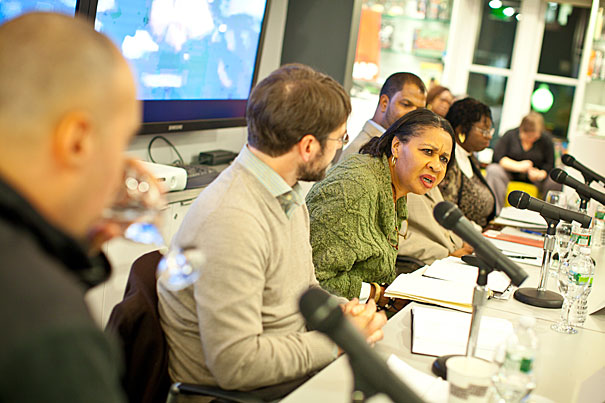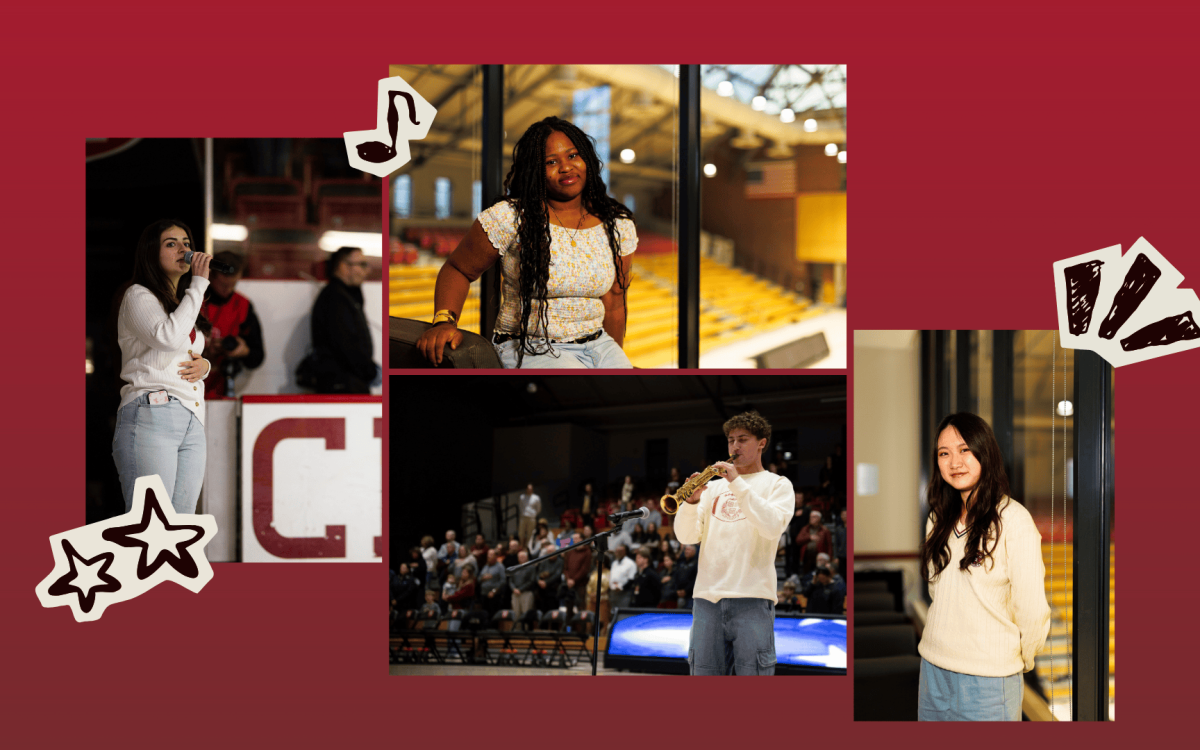
“I remember thinking: Why do boys dress like this?” observed panelist-critic Jamaica Kincaid, referring to the crosses, tags, chains, and other dangling glitter associated with hip-hop street culture. But then droopy pants and backward ball caps penetrated white culture in the suburbs, she said. “Now white children like black children and are pretending to be black children.”
Justin Ide/Harvard Staff Photographer
Hip-hop Harvard
Two young scholars produce new anthology of rap lyrics
Hip-hop at Harvard?
Well, yes. Harvard not only has its Hiphop Archive, part of the W.E.B. Du Bois Institute for African and African American Research since 2003, and the first of its kind. But it also has bragging rights on “The Anthology of Rap” (Yale University Press, 2010), edited by two young scholars who earned their Ph.D.s in English at Harvard in 2003. The hefty book is the first major print collection of lyrics from the musical form that in three decades has swept the world.
The foreword is by Du Bois Institute director Henry Louis Gates Jr., Harvard’s Alphonse Fletcher Jr. University Professor. “Rap’s tradition is as broad and as deep as any other form of poetry,” he wrote, though rap’s immediate antecedents go back to rhetorical street games called “the Dozens,” or signifying, or to “toasts” — long oral poems — that date back at least to the eve of World War I. (One of the earliest surviving toasts is called “Shine and the Titanic.”)
Soundbytes: Audio clip from the panel discussion
In 1990, Gates testified as an expert witness during a Florida obscenity trial over lyrics by the group 2 Live Crew, whose “Me So Horny” had hit the airwaves a year earlier. “Parody,” he told the court, “is one of the most venerated forms of art.”
Breaking those lyrics out of their music is one of the “greatest virtues” of the new anthology, Gates wrote in the foreword. “This is not a rejection of the music, but rather a reminder that the words are finally the best reason for the beat.”
The four-part anthology documents those words, from “The Old School” of 1978-1984 (starting with Afrika Bambaataa and Kurtis Blow) to the “2000-2010 New Millennium Rap” of Ludacris, Mos Def, and Young Jeezy. Young editors Adam Bradley and Andrew DuBois set out to “tell the story of rap as lyric poetry,” they wrote. “Rap is the poetry of hip-hop culture.”
Bradley and DuBois were in Cambridge recently (Nov. 18), in the first in a series called “The Author Meets the Critics” sponsored by the Hiphop Archive on Mt. Auburn Street. It may be the only Harvard real estate with a lit-up, mini disco floor, a blackboard for graffiti, and a chill collection of sneakers, gold chains, spray paint cans, and boom boxes.
“People have this stereotype of Harvard, but …” began archive executive director Marcyliena Morgan, who introduced the young editors and a panel of three critics. But the University produced the first hip-hop magazine, she said, and the first archive of hip-hop culture. (She is also a professor of African and African-American studies at Harvard, and author of the 2009 book, “The Real HipHop: Battling for Knowledge, Power, and Respect in the LA Underground.”)
“The one thing about the academy: We care who you are in great detail,” Morgan told the young rappers in the audience, who had been part of the program’s first session, an open lyrics reading.
“This started as a dream for us,” said Bradley of the nearly 900-page anthology. “It brought us together as friends, as different as we might be.” (Bradley, who is black, grew up in Salt Lake City, Utah. DuBois, who is white, grew up in northern Alabama.)
The book is an autobiography of sorts for both of them, said Bradley, the result of studying “Beowulf” and other canonical literature by day, and listening to rap at night.
It’s also a product of community, he said, of the artists whose credits and permissions cover nearly 40 pages, and of the friends and advisers who helped to shape the book’s original 500 offerings into 1,000 more — and then back down to a core of 300. “We stated thinking it would be the greatest mix tape of all, bound between two covers,” said Bradley, but in the end “you’re cutting things so vital to the tradition.”
The answer is to think of the anthology as more inspiring than inclusive, a way for fans and scholars alike to awaken to the poetry of rap. “School is inside of life,” and scholars need to look at the music of the streets, said DuBois.
As for students, he said: They already know rap, and rap shares the centrality of words, rhythm, time, and sound with poetry. “You’re talking about something on their playing field,” said DuBois about bringing rap into the classroom. “I’m personally fine with it.”
The need to bring rap into a poetic context, mixed with the context of contemporary culture, led to some rather jarring and unexpected pairings in the introduction and in the notes on the artists — Aristotle and Aesop mixing it up with Aerosmith and Almighty KG. (Other inclusions in the index: Donald Duck, John Wayne, and Robert Frost.)
During the panel discussion, DuBois brought Ludwig Wittgenstein’s “On Certainty” and Gustave Flaubert’s “Dictionary of Received Ideas” into the conversation with ease, along with “the importance of the vernacular” to gritty street poets of the 1960s, like LeRoi Jones (later Amiri Baraka) — voices that underlay the nativity of rap music in the Bronx of the 1970s. Today, he added, rap is “primarily a voice from our youth … this good, rich music and culture called hip-hop.”
But the anthology is missing a lot of that culture, said Bradley, a consequence mostly of spatial limits, but also of failures to secure some reprint permissions. (For instance, don’t look for lyrics from Notorious B.I.G.’s “Juicy.”)
“We could do another edition, and another after that,” said Bradley, though none is planned. Meanwhile, “We tried to make gestures toward the broadness of things,” he said. “We hope seeing the lyrics on the page [will] drive people to find the music.”
But a book of lyrics without sound? Panelist and ethnomusicologist Emmett G. Price III, a Northeastern University authority on hip-hop culture, wondered about the fate of the “sonic” in a book that is just words. “In every lyricist, there’s a ghost of the beat,” answered DuBois, and it makes sense to step back and study rap lyrics in a silent, uncluttered personal space. There were also logistical problems with adding a CD to the book, he said, including what would have been painful: “another stage of selection.”
Meanwhile, the book includes a “gesture” to the vivid and undeniable visual culture of hip-hop, said Bradley, by adding full-page pictures to lead each of the sections. “The Golden Age” (1985-1992) starts with a photograph of a high-haired black hipster with “Part 2” razored into his hairdo. “Part 3” (“Rap Goes Mainstream, 1993-1999”) is the centerpiece of a close-up of bling, the crosses, tags, chains, and other dangling glitter associated with hip-hop street culture.
“I remember thinking: Why do boys dress like this?” observed panelist-critic Jamaica Kincaid, a novelist who watched the early blooming of rap while writing for the Village Voice and The New Yorker in the 1970s. But then droopy pants and backward ball caps penetrated white culture in the suburbs, she said, puzzling parents with the fact that “the children they love are influenced by people they despise.”
Kincaid grew to “adore” the authenticity of girl rappers like Lil’ Kim, a fixture in the 1990s, and at the same time she noted the present “authentic inauthenticity” of a performer like Lady Gaga. “Now white children like black children,” she said, “and are pretending to be black children.”
And the future? “Part 4 is thinner than the other parts,” said Bradley of the anthology’s “New Millennium Rap” section, a look at stars of the past decade, like Jean Grae and Kanye West. “Who knows who people will talk about?” (The book has an even thinner final section called “Lyrics for Further Study.”)
Rap will live on as something worth studying, said panelist and critic Cheryl Keyes, an ethnomusicologist — with songs lately about AIDS, science, and the environment — and will “continue to penetrate the university,” despite predictions that it is dead or passé.
The future of rap holds more regional voices, predicted DuBois. That would complicate any future anthology. “Who would do the sifting?” he asked.
The future also holds a wider subject matter, said DuBois. As rappers who have day jobs emerge on the scene, rap will expand outward from where it started on the socioeconomic margins.
In the audience, as if to prove the point, was sociologist Reginald Stuckey. The former Du Bois Institute fellow, who called himself a “closet rapper,” has 90 songs closeted on YouTube as The Stuckey Project. His videos, clean and clever, run to a rap beat and show a lean, handsome black man in high-end clothes.
YouTube and other video portals on the Internet represent “a return to hip-hop in a grassroots format,” said Bradley, “but in a digital realm.”
Rap and the hip-hop culture that contains it move so fast that “scholarship can’t keep up,” said Kincaid. But that is “why the book resonates,” she said of the new anthology. It slows the process of looking at rap. “You need time to see if it means anything.”




